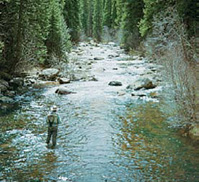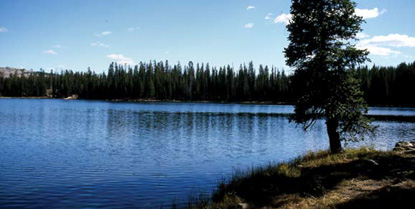Visibility
Do fish really see leaders and shy away from them, or is it more often an unnaturally moving fly that they avoid, or both? I believe fish notice the drag or unnatural motion imparted to the fly from an unnecessarily stiff leader rather than the visibility of the leader. The late Charles Brooks’s experiment using highly visible size A white winding thread as a tippet supports this theory. So called “leader shy fish” readily took Mr. Brooks’s fly when he fished it with size A thread. The thread was highly visible, but it was extremely flexible.
The new fluorocarbon leaders interest me. Underwater they seem to disappear. Consequently, I can get away with using a heavy leader, which is an advantage in fighting a fish. A loop knot tied to attach the fly to the tippet allows the fly excellent freedom of movement. Perhaps their other advantage is that fluorocarbon leaders are denser than monofilament leaders and inherently sink. A floating leader seems to disturb the surface film because its movements reflect light and cause waves. A sunken leader does not disturb the surface. In short, when fishing for highly educated trout I opt for either a long flexible tippet or a fluorocarbon tippet with a loop knotted fly.
Sinking line leaders are simply three to five foot sections of tippet slightly tapered and attached to about one foot of heavy leader attached to the fly line. Leader Test: A leader’s “test” refers to its relative strength and size.
I prefer to use heavier tippets than most other fishermen. I like to forcibly fight my fish so that they can be quickly released unharmed by fatigue. I get away with heavier tippets by using a very flexible material such as Dai Riki Velvet or a fluorocarbon tippet with a loop knot fly attachment. My tippets generally average about four feet in length. This system gives me adequate strength for fighting fish, pulling out snags, and abrasion resistance.
The general rule about leader length is occasionally broken when fishing sinking lines in lakes that are weed infested. Under these conditions, I use a long leader that buoys upwards somewhat and allows me to retrieve line out of the thick weed beds. I also use a slightly faster sink rate line than ordinarily needed with this long leader. The buoyed fly is pulled downward during the retrieve; likewise the fly buoys upwards during the pause. The faster sinking line gets my fly down quickly and saves time. The rise and fall of the fly is an effective retrieve. A slightly buoyant fly pattern accentuates this motion. Flies tied with deer hair such as Werner shrimp and Muddler minnows are effective. The leader length I use varies between 8 and 10 feet.
When fishing a dry fly, I lessen water splash due to casting by using a longer than normal leader. Fifteen-foot leaders carry fewer water droplets and are useful in very calm, clear water conditions. They make transparent false casting above the fish less noticeable and less likely to cause alarm. Lake fishing with midges and a floating line may require extraordinarily long leaders. When retrieved towards the surface, these long leaders permit flyfishers to imitate the slow ascent of midge pupa. The extreme

lengths allow these leaders to sink to the bottom.
Loop to loop leader connections are popular because they facilitate easy and fast changes to a new or different sized tippet. Their disadvantage is that the loops may hang up a fly cast with a tailing loop.
Wind knots severely weaken leaders. When I discover one, I replace the wind knotted section of the leader or untie the wind knot if it hasn’t yet pulled tight.
The butt section needs to be a next size lower than fly line diameter. Leaders taper towards the tippet in progressively finer diameters to permit the casting loop to unfurl the leader on delivery.
Heavily wind resistant flies call for stiffer materials to straighten out the leader. Casting a tight loop increases the fly’s momentum by increasing the line speed. Small flies require smaller diameter and more flexible leaders to cast properly.
It’s best to become a proficient caster: a well cast leader will always straighten upon delivery. Controlling line speed and loop

size are important casting skills. The most demanding conditions are those of crystal clear waters with smooth surface flows and mini current disturbances caused by weeds and minor obstructions. Fishing the surface under these conditions demands the most from a leader. You can overcome these adversarial conditions by using as flexible a leader as possible. A stiff leader causes the fly to float unnaturally.
I like my leaders to sink just under the surface. When leaders float, they disturb the surface by reflecting light and causing ripples. Leader sink products are useful, and so are techniques like pre-wetting the leader prior to casting or rubbing mud or weed slime on the leader. Just prior to fishing, you can also soak a leader in a water-filled zip lock bag.


© 2025 The Gale Group, Inc. All rights reserved.
© 2025 Perigee Learning LLC. All rights reserved.
LoveTheOutdoors.com is owned and operated by Advameg, Inc. © 2025 Advameg, Inc.
Camping Adventures • Dutch Oven Cooking • Sports Knots
Fly Tying • Freshwater Fishing • Fly Fishing

